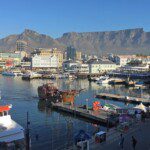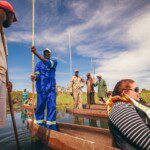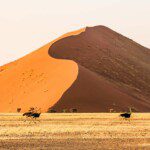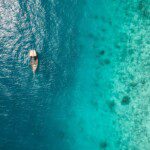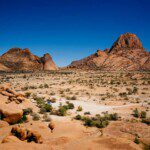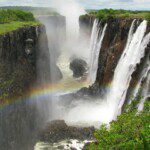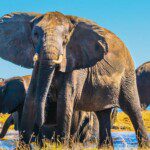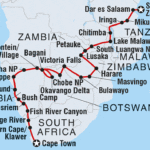Cape Town to Zanzibar
Travel from the southern tip of South Africa to Tanzania’s famous Spice Island on this epic Overland journey through Africa. Starting in Cape Town, head through remote deserts, rolling savannas and lush mountains; cruise delta waterways by canoe, feel the spray of the massive Victoria Falls and meet locals in rural villages. Take 4WD safari drives through three national parks in search of elephants, lions and hippos, relax on pristine beaches and sample local cuisine on this all-encompassing African adventure.
41 days, from
$6,225
per person
GROUP SIZE
ACTIVITY LEVEL
Details
Countries Visited:
Botswana
Malawi
Namibia
South Africa
Tanzania, United Republic Of
Zambia
Zimbabwe
Accommodation: Camping (with facilities) (31 nights), Camping (with basic facilities) (1 night), Camping (without facilities) (1 night), Cabin (3 nights), Hotel (2 night), Bunglow (2 night)
Transportation: Overland vehicle , 4x4 Safari Vehicle , Mokoro , Ferry , Minibus
Included Meals:
- 37 breakfasts
- 22 lunches
- 30 dinners
Group size: Minimum 1, Max 22
Minimum Age: 15
Listen to the songs and stories of Namibia’s San people, the oldest inhabitants of Southern Africa, and gain an insight into their traditional customs and beliefs.
Enjoy a full-day game drive in Etosha National Park, home to a wide range of Southern Africa's wildlife, and glide through the waterways of the Okovango Delta on a mokoro (a small dugout canoe), escaping civilisation at with an overnight stay at an island camp.
The cascades and evaporating mist of Victoria Falls are a wondrous sight. Have the opportunity to see the falls at multiple angles, perhaps with a bird’s eye view in a helicopter!
Visit the Victoria Falls Wildlife Trust to learn about the rehabilitation of wildlife from poaching and get the chance to meet some rescued or orphaned wildlife currently in their care.
Journey from the interior plains out to some idyllic Indian Ocean hotspots. Take a stroll along the shores in Dar es Salaam and laze on the beaches in paradisiacal Zanzibar.
Itinerary
Sawubona! Welcome to South Africa. With its stunning coastline, modern cityscape and nearby mountains, Cape Town is one of Africa's most exciting cities. Your adventure begins with a welcome meeting at 6 pm this evening. You can arrive at any time as there are no activities planned until this important meeting. If you do happen to arrive early, why not get out and explore Cape Town, perhaps taking a walk in Newlands Forest, jumping on the Table Mountain Aerial Cableway, or heading down to the waterfront to see Cape Town Stadium up close.
Leaving Cape Town behind, travel up the Western Cape (approximately 6 hours). Sit back, relax and enjoy the sprawling scenery. Tonight, you will stay on a working farm with your small group. This is a great chance to gain an insight into everyday life in this remote part of South Africa.
Journey to the Orange River, the beautiful natural border between South Africa and Namibia (approximately 9 hours). En route you will pass through Namaqualand, which is renowned for its wildflowers that spring up from late July to mid-September. Traditionally known as the Gariep River, the Orange River is the longest in South Africa (2200 km). Its source is high up in the Drakensberg mountain range in Lesotho, and it flows into the Atlantic Ocean at Alexander Bay in South Africa.
This morning there is the chance for an optional canoe adventure on the Orange River. Floating leisurely down the stream is a great way to discover the beauty of this region. Head further west into the desert lands of Namibia towards Fish River Canyon (approximately 4–5 hours). At 500 metres deep and over 160 km long, Fish River Canyon is one of the largest canyons in the world. At any time of year there are remarkable photographic opportunities here as you watch the colour of the granite rocks change as the sun goes down.
Be ready for a long travel day as you drive toward the fabled dunes of Namibia (approximately 10 hours). You will have the opportunity to stop at a market or shop to stock up on supplies before tomorrow's bush camp. Upon arrival, stretch your legs and take in the exciting desert scenes. You will be situated in the most famous part of the Namib Desert, among the vast dune fields, the most spectacular of which are found near the Sesriem Canyon. Get an early night in preparation for your dawn hike tomorrow.
Wake up before dawn and scramble to the top of the dunes for a dramatic sunrise view across a vast sea of sand. The colour changes as the sun creeps up above the horizon, and the views are nothing short of incredible, providing a spectacular setting for your brunch. The dunes themselves are some of the highest in the world and home to much animal life. Afterwards, jump in the back of a pickup truck for a trip to Sossusvlei – the incredible salt and clay pan just nearby (approximately 30 minutes each way). You'll have plenty of time to explore this mysterious desert oddity. In the afternoon, drive to your bush camp in the heart of the Namib Desert (approximately 4 hours).
Continue to Swakopmund (approximately 4 hours). Surrounded by the massive dune fields of the Namib Desert on three sides and the Atlantic Ocean on the other, Swakopmund is an ideal place for outdoor activities. The township has an interesting German–Namibian atmosphere, which makes it a pleasant place to simply walk around and explore.
With free time today, it's worth checking out the Germanic architecture and taking advantage of some excellent souvenir shopping. If you're after a dose of history and culture, you can stop in at the lighthouse and visit the Swakopmund Museum. Active types and thrill-seekers might like to take advantage of the many outdoor activities on offer – this town is the adventure-sports mecca of Namibia.
With another free day in this beautiful seaside town, you might like to do some reading, relaxing and swimming. Alternatively, you can venture further afield – perhaps to the Okakambe Trails or the Camel Farm (both located in the same area, around 12 kilometres east of town). A horse ride or camel ride is a great way to see the desert from a different perspective.
Travel to Spitzkoppe (approximately 6 hours). Experience the sight, sound and smell of thousands of olive-coloured seals on the shores of Cape Cross while travelling up the Atlantic Coast. Visit one of the most stunning areas of Namibia, the wild lands around the mountain of Spitzkoppe, also known as the Matterhorn of Namibia. Although you shouldn't try to climb to the top, there are some excellent hikes and guided walks throughout the area, which is rich in plant life and even has some bush paintings to be found. The Spitzkoppe is known for its stunning beauty and the thousands of ancient Bushmen rock art paintings that are still viewable. Be sure to look out for the sunset from your bush camp this evening – the landscape is known to take on dazzling oranges and reds.
This morning, set off and travel to Etosha National Park (approximately 9 hours), stopping at a market or shop and ATM if required. Etosha is among the world's premier places to view wildlife. A wide range of southern Africa's wildlife roams here, including all the big carnivores and the five rare or endangered species: black rhino, Hartmann's mountain zebra, black-faced impala, roan antelope and the tiny Damara dik-dik. Tonight, there is an option to take an evening game drive in the park before spending the night at the particularly spectacular Okaukuejo Camp. The camp overlooks a floodlit waterhole visited by many different species throughout the day and night.
Enjoy a full-day game drive in Etosha National Park. Game viewing in the park is relatively easy due to the constructed waterholes and the large, sparsely vegetated pans. The bushland surrounding the pans is difficult to see through, but there are enough clearings, pans and waterholes to usually allow for some sightings. Namibia has protected its game reserves against poaching, which means significant numbers of elephants, antelope and other herbivores reside here. This evening you will spend the night at Namutoni Camp.
Leaving Etosha behind and continue to your camp which is located 50 kilometres outside Grootfontein (approximately 5 hours). This will be your base for visiting the San people tomorrow. Arrive at your camp, stretch your legs, perhaps enjoy a cool drink and kick back with your fellow travellers.
Embark on a 180-kilometre round-trip to visit the San people. You will go out walking with some of the tribe, listening to their stories and songs. You'll soon discover that they communicate in a unique and fascinating Khoisan dialect, commonly known as a 'clicking' language. The San are the oldest ethnic group in Namibia, having inhabited southern Africa for an estimated 20,000 years. Around 30,000 of them live in Namibia, but only 2000 still follow a traditional way of life. The San have a deep understanding of nature and ecology, living in harmony with their environment.
Head to Bagani, where you will set up camp for the night. Bagani is a small, friendly town with some good hiking trails along the river and plenty of nice spots in which to relax and soak up the ambience. This area is the homestead of the local Mbukushu kings.
Drive across the border into Botswana and head south along the Okavango Panhandle (the narrowest part of the delta) to Seronga. Here you'll leave your vehicle and join your transport for the journey into the delta (approximately 4 hours). Boarding boats out into the swamps, travel to Gao Island to meet your mokoro team and start exploring the Okavango Delta with them. Each mokoro (small dugout canoe) takes two people and is poled along through the meandering waterways by a local tribesman. Punting along past birds and lily pads, you'll hear hippos occasionally piercing the peaceful atmosphere with their charming grunts. On the first night here, you'll camp on an island away from civilisation.
Continue your trip around the delta and then return to Gao Island before heading to the relative civilisation of Umvuvu Camp with its (usually) hot showers and small bar. Today there is an option to take a nature walk with your guide. This is a great chance to discover the beautiful natural surrounds, gain some insight into the history of the local area and look out for animals such as giraffe, zebra and elephants.
After your exciting Okavango adventure, return to Bagani for the night. There will be time to relax, or to take part in one of the many activities on offer. Bagani offers a range of boat trips and fishing excursions. There are also many excellent hiking trails to explore. Ask your leader about how to take up one of these options.
Setting off from Bagani this morning, embark on a pretty long drive (approximately 8 hours). Don’t fear – your destination, the incredible Chobe National Park, will be well worth it. Enter Botswana at Goma border, which is also the gateway to the park. Once arrived, take an optional cruise down the Chobe River – one of the best ways to witness some of the park's many animals.
Enjoy an early-morning game drive. Adventuring through the park, you’ll have the opportunity to get up close to the wildlife. With luck you’ll spot a variety of creatures – lions, buffaloes and any number of exotic birds. Botswana's first national park is famous for its high concentration of elephants, so keep an eye out for them. They can often be seen swimming in the Chobe River. The river also attracts cheetahs, hippos, and crocodiles who like to sun themselves by the water's edge. In the afternoon, perhaps take an optional boat cruise to gain a different view of these amazing animals.
Travel on to Victoria Falls (approximately 3 hours), crossing the border into Zimbabwe in time to have lunch on the banks of the Zambezi. Though a visit to Victoria Falls' is optional, it is highly recommended – if you didn’t see the waterfall, have you actually been to Victoria Falls? The staggering curtain of water is about 1.6 kilometres and cascades 108 metres into a narrow gorge below. In the wet season, the spray created can rise up an incredible 400 metres and the falls become an impressive raging torrent. In the dry season, the view of the falls is unobstructed by spray and you can see little islets in the river below. Gather your travel crew together tonight for dinner, celebrating the southern Africa adventure and memories you’ve shared.
Today is a free day to enjoy the many activities on offer. If you are interested in the optional helicopter flight (12 minutes or 25 minutes) we endorse the following operator only: Zambezi Helicopter co CAA Zimbabwe. Your leader can help you arrange this and recommend a variety of other activities to ensure you make the most of your free time.
Another day in Vic Falls? Yes please! Join your new and improved crew for a day to explore the town, the waterfalls and its surrounds.
Depart Victoria Falls and travel toward Bulawayo (approximately 7 hours) via the Victoria Falls Wildlife Trust – one of The Intrepid Foundation’s projects. Here you can learn about the rescue and rehabilitation of wildlife, human-wildlife conflict and the trusts role in anti-poaching. There may also be a chance to meet any rescued or orphaned wildlife currently in their care. Onwards to Bulawayo – known locally as the 'City of Kings', Zimbabwe's second-largest city has an interesting history and some impeccable colonial architecture.
Perhaps get up early and take the option to go to Matobo National Park. Home to a significant population of black and white rhinoceros that can be tracked on foot, Matobo National Park is also the site of the grave of Cecil John Rhodes, the founder of Rhodesia and the De Beers diamond company. The Matopos area has great spiritual and cultural significance to the local people and there are many sites within the park where important ceremonies still take place. This optional activity is highly recommended, otherwise you could head into town to check out the local museums or take the opportunity for some down time.
Drive the short stretch to Masvingo (approximately 5–6 hours). This colonial settlement – the oldest in Zimbabwe – makes for the perfect base from which to explore the Great Zimbabwe Ruins. The ruined city, now a World Heritage-listed site, was first constructed in the 11th century. It's thought to be the former royal palace of the Zimbabwean monarch. Spend a few hours exploring this intriguing site before heading off to camp for the evening.
Travel to Harare today (approximately 5–6 hours). You will arrive at your destination in time for lunch. You only have an hour or two to explore Zimbabwe's capital city, so if you're feeling active and up for a stroll, get out and make the most of it. Perhaps head to the National Gallery, the museum, the botanical gardens or simply wander the city centre and visit the colourful markets.
Today you will cross into Zambia and drive to your campsite just outside Lusaka, Zambia's capital (approximately 8 hours). Your journey begins with a nice scenic drive to the border. At some point during the day there will be an opportunity to stop at an ATM and stock up on any supplies you might need at a shop or market.
Spend some time checking out Lusaka before a long day of travel. You'll see that it's a modern city but still retains a traditional African feel. Afterwards, travel on to Petauke (approximately 8 hours).
After breakfast, travel (approximately 4 hours) to a workshop in South Luangwa where local craftswomen take snare wire recovered from poaching traps and transform it into jewellery inspired by the African bush. The women will show you around their purpose-built workshop and give you a chance to try coiling or hammering the wire yourself. For each sale made, a donation is given to anti snare patrols dedicated to the conservation of the region. Afterwards, make your way through the heartland to South Luangwa National Park (approximately 2 hours). The concentration of animals around the Luangwa River and its lagoons is among the highest in Africa. Many elephants, buffaloes, leopards, Thornicroft’s giraffes and lions are known to roam here. There are also some 400 species of birds inhabiting the area. A great way to experience South Luangwa and its beautiful scenery is to take an optional river trip – ask your group leader for more details.
Rise early for an exhilarating morning game drive in a 4WD vehicle. Enjoy classic savanna scenery while keeping your eyes peeled the parks abundance of wildlife. There’s every chance you may spot a herd of zebra grazing on parched grass or a pride of lions passing by. Midday is the hottest part of the day here, so seek refuge from the sun and return to the camp for lunch. Afterwards, perhaps head out on a village walk for a snapshot of daily life in the local community. An optional game drive at night is also a good option to see wildlife when they are most active.
Cross the border into Malawi and continue straight to your camp on the shores of Lake Malawi (approximately 9–10 hours). Malawi is dominated by its lake, which covers almost a fifth of the country and provides a livelihood for many local people. Fishermen, fish traders and canoe and net makers all ply their trade on the lake. A common sight is that of a fisherman in a bwato (a dugout canoe made from a hollowed tree trunk) fishing on the still lake at the break of day. Your campsite at Kande Beach is right on the shore, so take some time to rest and relax.
Take a dip in the lake this morning as you head out on a snorkelling trip with a local guide. Lake Malawi's high alkalinity has resulted in an abundance of brightly coloured fish and relatively low levels of plants. What you end up with is a tropical oceanlike snorkelling experience within a landlocked freshwater lake. This afternoon, enjoy free time to soak up your idyllic surrounds. As well as chilling out on the lake’s sandy shores, make sure you take the opportunity to meet some local Malawians – easily some of the friendliest people in Africa.
Drive to your camp in Chitimba (approximately 8 hours). Chitimba lies along the coast of Lake Malawi and has lovely beaches, friendly locals and a laidback atmosphere. When you arrive, perhaps take a stroll and acquaint yourself with this different part of the lake. Enjoy the scenery of banana palms, papaya trees and the Livingstonia and Nyika mountains looming nearby.
Today is a long travel day into Tanzania and its southern highlands (approximately 11 hours). Sit back, relax and watch as the countryside passes by. On arrival you will set up camp on the grounds of a farmhouse situated on the outskirts of this pleasant settlement.
Wake up early this morning to head off on a 4WD game drive into Mikumi National Park with local expert guides. This less touristed park is home to impressive numbers of elephants, hippos, giraffes, zebras, buffalo, warthogs, wildebeest and impalas – and maybe even a predator or two if you're lucky! Afterwards, we'll drive to Iringa (approximately 5 hours) and set up camp on the grounds of a farmhouse on the outskirts of this pleasant settlement. The area is filled with natural bush land which can make it a bird watchers paradise. Make the most of this rural setting by doing some stargazing before you retire for the night.
Settle in for a 7-hour drive to Kipepeo Beach, just south of Dar es Salaam. Be sure to make the most of it – perhaps take a stroll along the shore after you arrive and settle in. Your camp today is on the grounds of a hotel situated next to the beach.
Catch a ferry to Africa's 'Spice Island' of Zanzibar. Filled with pristine white-sand beaches, winding cobblestone alleyways and fragrant bazaars, Zanzibar has had a colourful history – everything from slave traders to Arabian sultans and fruit exporters. The sight of traditional dhows sailing along the coast evokes what the island must have been like in centuries ago. The old part of Zanzibar's main city is known as Stone Town, and the best way to see this is on foot, exploring the markets, shops, mosques, palaces and courtyards. When the sun is setting, why not grab a drink from a bar overlooking the seafront. A seafood curry at a local restaurant is also a great choice. You'll spend the night in Stone Town at a basic inn.
Once checked out of your Stone Town accommodation, consider booking in to an optional guided tour of the island's spice plantations, learning all about the history of this town's spice trade. You will have the opportunity to smell and taste various spices, such as cinnamon, vanilla and ginger, plus sample some teas made with these spices too. After lunch, head to the Northern Beaches, where white sands and sparkling blue seas await. This is the Indian Ocean at its best.
Enjoy free time in this beautiful archipelago today. There are many ways you can spend your day – perhaps talk to your leader for any recommendations they might have. Snorkelling in search of exotic fish is an excellent option, or you could take a traditional dhow boat on the water. You might also like to feast on a sumptuous lunch of grilled local seafood, or just relax in a hammock underneath a coconut tree with a good book. It's totally up to you!
After checking out of your accommodation this morning, you will make your way back to Stone Town, arriving at a centrally-located hotel around 12 pm. With no activities planned for today, you are free to leave at any time. That doesn't mean your adventure has to come to an end! If you wish to stay on in Zanzibar, either at the Northern Beaches beach resort or in Stone Town, we'll be happy to organise additional accommodation (subject to availability).

